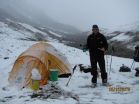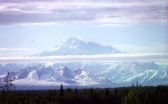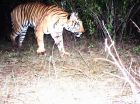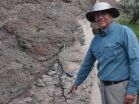Professor Paul Fitzgerald and a team of students and fellow scientists have been studying the Alaska Range along the Denali fault. They think they know why the fault is located where it is and what accounts for the alternating asymmetrical, mountain-scale topography along the fault.
Their findings were the subject of a recent paper in the journal Tectonics (American Geophysical Union, 2014).
In 2002, the Denali fault, which cuts across south-central Alaska, was the site of a magnitude-7.9 earthquake and was felt as far away as Texas and Louisiana. It was the largest earthquake of its kind in more than 150 years.
"Following the earthquake, researchers flocked to the area to examine the effects," says Fitzgerald, who serves as professor of Earth Sciences and an associate dean for the College. "They were fascinated by how the frozen ground behaved; the many landslides [the earthquake] caused; how bridges responded; and how the Trans-Alaska oil pipeline survived, as it was engineered to do so."
Geologists were also surprised by how the earthquake began on a previously unknown thrust-fault; then propagated eastward, along the Denali fault, and finally jumped onto another fault, hundreds of kilometers away.
"From our perspective, the earthquake has motivated analyses of why the highest mountains in the central Alaska Range occur south of the Denali fault and the highest mountains in the eastern Alaska Range occur north of the fault--something that has puzzled us for years," Fitzgerald adds. "It's been an enigma staring us in the face."
He attributes the Alaska Range's alternating topographic signatures to a myriad of factors: contrasting lithospheric strength between large terranes (i.e., distinctly different rock units); the location of the curved Denali fault; the transfer of strain inland from southern Alaska's active plate margin; and the shape of the controlling former continental margin against weaker suture-zone rocks.
It's no secret that Alaska is one of the most geologically active areas on the planet. For instance, scientists know that the North American Plate is currently overriding the Pacific Plate at the latter's southern coast, while the Yakutat microplate is colliding with North America.
As a result of plate tectonics, Alaska is an amalgamation of terranes that have collided with the North American craton and have accreted to become part of North America.
Cratons are pieces of continents that have been largely stable for hundreds of millions of years.
Terranes often originate as volcanic islands (like those of Hawaii) and, after colliding with one another or a continent, are separated by large discrete faults. When terranes collide and accrete, they form a suture, also known as a collision zone, which is made up of weak, crushed rock. During deformation, suture-zone rocks usually deform first, especially if they are adjacent to a strong rock body.
"Technically, the Denali fault is what we'd call an 'intercontinental right-lateral strike-slip fault system,'" says Fitzgerald, adding that a strike-slip fault occurs when rocks move horizontally past one another, usually on a vertical fault. "This motion includes a component of slip along the fault and a component of normal motion against the fault that creates mountains. Hence, the shape of the fault determines which of the two components is predominant and where mountains form."
In Alaska, the shape of the accreted terranes generally controls the location of the Denali fault and the mountains that form along it, especially at the bends in the trace of the fault.
Fitzgerald: "Mount McKinley and the central Alaska Range lie within the concave curve of the Denali fault. There, higher topography and greater exhumation [uplift of rock] occur south of the Denali fault, exactly where you'd expect a mountain range to form, given the regional tectonics. In the eastern Alaska Range, higher topography and greater exhumation are found north of the fault, on its convex side--not an expected pattern at all and very puzzling."
Using mapped surface geology, geophysical data, and thermochronology (i.e., time-temperature history of the rocks), Fitzgerald and colleagues have determined that much of Alaska's uplift and deformation began some 25 million years ago, when the Yakutat microplate first started colliding with North America. The bold, glacier-clad peaks comprising the Alaska Range actually derive from within the aforementioned "weak suture-zone rocks" between the terranes.
While mountains are high and give the impression of strength, they are built largely from previously fractured rock units. Rock movement along the Denali fault drives the uplift of the mountains, which form at bends in the fault, where previously fractured suture-zone rocks are pinned against the stronger former North American continental margin.
"The patterns of deformation help us understand regional tectonics and the formation of the Alaska Range, which is fascinating to geologists and non-geologists alike," says Fitzgerald. "Being able to determine patterns or how to reveal them, while others see chaos, is often the key to finding the answer to complex problems. ... To us scientists, the real significance of this work is that it helps us understand the evolution of our planet, how faults and mountain belts form, and why earthquakes happen. It also provides a number of hypotheses about Alaskan tectonics and rock deformation that we can test, using the Alaska Range as our laboratory."
INFORMATION:
In addition to Fitzgerald, the paper was co-authored by Sarah Roeske, a research scientist at the University of California, Davis; Jeff Benowitz, a research scientist at the Geophysical Institute at the University of Alaska Fairbanks; Steven Riccio and Stephanie Perry, graduate students in Earth Sciences at Syracuse; and Phillip Armstrong, professor and chair of geological sciences at California State University, Fullerton.
Housed in Syracuse's College of Arts and Sciences, the Department of Earth Sciences offers graduate and undergraduate degree opportunities in crustal evolution and tectonics, environmental sciences and climate change, hydrogeology, sedimentology and paleolimnology, geochemistry, and paleobiology.






